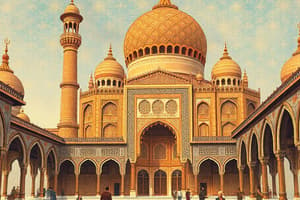Podcast
Questions and Answers
What approach did Akbar take to govern his empire?
What approach did Akbar take to govern his empire?
- He encouraged strict religious divisions among his subjects.
- He reconciled with both Hindu and Muslim warrior aristocracy. (correct)
- He focused solely on military expansions.
- He limited land grants to only Muslims.
Which practice did Akbar eliminate during his rule?
Which practice did Akbar eliminate during his rule?
- Sati (correct)
- Taxation on textiles
- Religious education for women
- Land grants to nobility
What was a significant consequence of Aurangzeb's rule?
What was a significant consequence of Aurangzeb's rule?
- Increased tolerance towards Hindu practices.
- Expansion of trade routes with Europe.
- Depletion of the treasury due to prolonged warfare. (correct)
- Establishment of peace treaties with neighboring empires.
Which of the following correctly describes Din-i-llahi?
Which of the following correctly describes Din-i-llahi?
What cultural contributions are attributed to the Mughal Empire?
What cultural contributions are attributed to the Mughal Empire?
What event in 1453 marked the end of Christian control in the Middle East?
What event in 1453 marked the end of Christian control in the Middle East?
What role did the Janissaries primarily serve within the Ottoman military?
What role did the Janissaries primarily serve within the Ottoman military?
What characterized the Ottoman sultans' approach to maintaining power?
What characterized the Ottoman sultans' approach to maintaining power?
What was a significant consequence of the Ottoman Navy losing at the Battle of Lepanto in 1571?
What was a significant consequence of the Ottoman Navy losing at the Battle of Lepanto in 1571?
Which group primarily composed the Janissaries in the Ottoman Empire?
Which group primarily composed the Janissaries in the Ottoman Empire?
What was a significant outcome of the Battle of Chaldiran in 1514?
What was a significant outcome of the Battle of Chaldiran in 1514?
Which of the following describes the socio-political structure of the Safavid empire after their defeat?
Which of the following describes the socio-political structure of the Safavid empire after their defeat?
What was a strategic failure of Muslim empires in relation to their expansion?
What was a strategic failure of Muslim empires in relation to their expansion?
Which factor hindered the westward advance of Shi'ism as a result of the Battle of Chaldiran?
Which factor hindered the westward advance of Shi'ism as a result of the Battle of Chaldiran?
What was one of the key characteristics of the Safavid economic structure post-defeat?
What was one of the key characteristics of the Safavid economic structure post-defeat?
Flashcards
Mughal Empire
Mughal Empire
A powerful empire in India, influenced by the military tactics of the Ottoman Empire.
Akbar's Rule
Akbar's Rule
Akbar's reign was marked by attempts at social change, including reconciliation of Hindu and Muslim aristocratic classes, unification efforts with Din-i-llahi, and efforts to regulate alcohol.
Din-i-llahi
Din-i-llahi
Akbar's attempt to create a unified religion combining elements of Islam and Hinduism.
Mughal Decline
Mughal Decline
Signup and view all the flashcards
Persian/Hindu cultures blend
Persian/Hindu cultures blend
Signup and view all the flashcards
Ottoman Navy Strength
Ottoman Navy Strength
Signup and view all the flashcards
Janissaries
Janissaries
Signup and view all the flashcards
Ottoman Military
Ottoman Military
Signup and view all the flashcards
Loss of Eastern Mediterranean Control
Loss of Eastern Mediterranean Control
Signup and view all the flashcards
1453 Constantinople Capture
1453 Constantinople Capture
Signup and view all the flashcards
Battle of Chaldiran (1514)
Battle of Chaldiran (1514)
Signup and view all the flashcards
Safavid Defeat
Safavid Defeat
Signup and view all the flashcards
Limited European Technology Adoption
Limited European Technology Adoption
Signup and view all the flashcards
Failed Overseas Expansion
Failed Overseas Expansion
Signup and view all the flashcards
Lack of Empire Unification
Lack of Empire Unification
Signup and view all the flashcards



